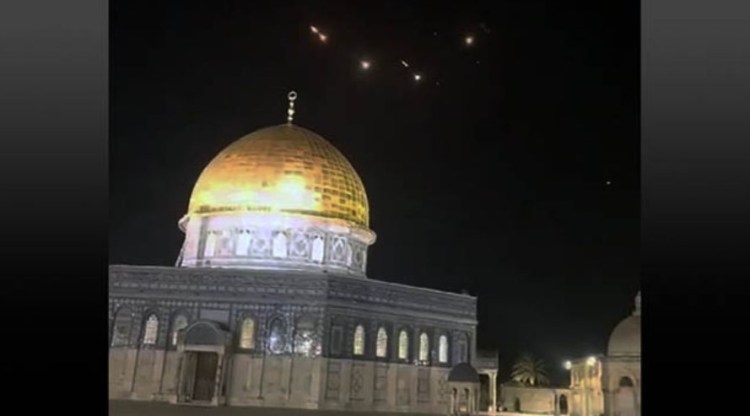On April 13, the Aerospace Force of the Islamic Revolutionary Guards Corps (IRGC) initiated a significant aerial offensive named “True Promise,” launching drones and missiles from sites in Kermanshah and Dokuh, Iran, directly targeting Israel. This marked a historic first for direct assaults from Iran.
A Retaliatory Strike
The IRGC declared the operation started at approximately 15:30 EST, following approval from Iran’s Supreme National Security Council and supervision by the Armed Forces General Staff. The assault involved multiple waves, deploying hundreds of drones, including Shahed-136 one-way attack models, over several hours.
Used with permission from the Institute for the Study of War.
During this period, defense forces from the United States, United Kingdom, Israel, and Jordan actively intercepted the incoming projectiles outside Israeli airspace, reported between 1700 and 1800 ET. Over 300 drones and missiles were launched, according to the IDF, with airspaces over the region, including over Jordan and Lebanon, being shut down temporarily.
The attack on Israel coincided with actions by groups within Iran’s “Axis of Resistance.” Hezbollah, from Lebanon, claimed it launched rockets at Israeli military sites at the same time as the IRGC’s first wave. Additionally, the Houthis and the Iraqi militia Faylaq al Waad al Sadiq released statements and media supportive of the operation, with the latter celebrating their role in the attack.
Apparently, President Biden’s monosyllabic warning was not enough to put the fear of Allah in the Iranians.
Israel’s security cabinet convened urgently in response and remained in ongoing discussions. Protective measures were swiftly implemented, including airspace closures and heightened alert statuses across military bases and border regions. Iran’s clear warnings to the U.S. and Jordan cautioned against interference, with threats of broader regional escalations if they supported an Israeli counterstrike.
Iran’s IRGC Navy further escalated the situation by seizing a Portuguese-flagged vessel linked to an Israeli shipping magnate in the Strait of Hormuz, indicating a broader strategy to pressure regional adversaries and disrupt Israeli connections through the Persian Gulf. This action, along with verbal threats towards the UAE, underscored the broader regional implications of the conflict and the potential for extended disruption of international trade routes.
Celebrations in the Streets of Tehran
Early Sunday in Iran, thousands gathered in cities like Tehran and Isfahan to express their support for the ongoing drone and missile strikes against Israel, which marked an unprecedented escalation in the war in the Middle East. The public demonstrations followed the Iranian Revolutionary Guards’ announcement of “Operation True Promise.”
Celebrating the attacks in the streets of Tehran.
In Tehran, participants assembled in Palestine Square, vocalizing anti-Israel and anti-America sentiments.
“Death to Israel!” and “Death to America!” they shouted.
They were surrounded by freshly made signs of defiance, including a new mural proclaiming “the next slap is fiercer” and a banner warning Israelis in Hebrew to “take shelter.” The streets saw waves of Iranian and Palestinian flags, with many banners heralding the imminence of “God’s victory.”
The catalyst for these demonstrations was a retaliatory act for the April 1 airstrike that devastated an Iranian diplomatic facility in Damascus, killing seven Revolutionary Guards members, including two generals. This attack was widely attributed to Israel, sparking vows of retribution from Tehran, including a statement from Iran’s Supreme Leader Ayatollah Ali Khamenei promising punitive measures against the “evil regime.”
A Coordinated, Multifaceted Attack
The attacks on Israel were characterized as multifaceted, involving not just Iran but also its allies in Yemen, Lebanon, and Iraq, striking from multiple directions, according to Iran’s media.
Amid these demonstrations, tensions outside the British embassy in Tehran escalated, and crowds gathered at significant sites in other cities. In Isfahan, mourners paid respects to General Mohammad Reza Zahedi at his burial site, while in Kerman, tributes were paid at the grave of Qasem Soleimani, the famed Guards commander killed by a U.S. drone in 2020.
Despite Iran’s appeal to the U.S. to stay out of the fray, the Pentagon confirmed U.S. forces had intercepted drones heading for Israel, signaling a complex and expanding confrontation.
The broader context includes ongoing conflict in Gaza, initiated by a Hamas attack on October 7, resulting in significant casualties. While Tehran supports Hamas, it has denied direct involvement in its actions against Israel. The response from Israel has been severe, with a substantial toll on life in Gaza.
As fears of a wider war loom, voices within Iran express mixed feelings. Some, like Maryam, a 43-year-old professional, hope for a diplomatic resolution to prevent war and safeguard innocent lives. Salehi, aged 75, hopes for a rational approach from the government. Yet others like Ehsan, a university professor, see retaliation as a logical step. However, he acknowledges the grave nature of war, suggesting that sometimes, war is a necessary path to peace.
Time, as they say, will tell.
While we wait to see what the future holds, one can bet that the nation of Israel will not allow these attacks to go unanswered. If the past is prologue, blood will be shed.
And so it goes.
Keep checking back with SOFREP for ongoing coverage of the war in the Middle East.



